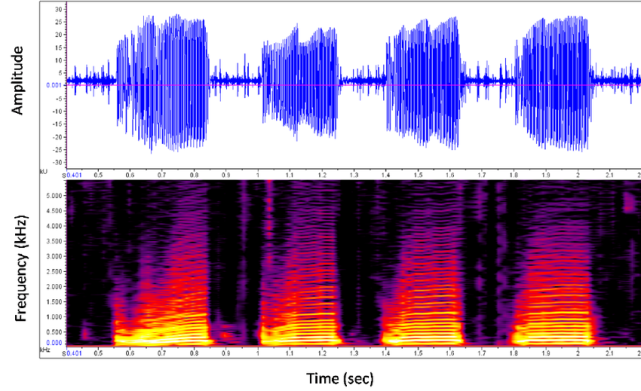Contemporary young people are used to talking about “emo” as a mantra, ignoring what the real “depression” means. If people’s emotions also have “values”, how can emotional testing be as simple as measuring body temperature and blood pressure?
Artificial intelligence technology is using sound to explore the emotional information it releases, from respiratory diseases to physical diseases such as Parkinson’s disease and chronic geriatric disease, and mental diseases such as depression, postpartum depression, cognitive impairment, and concussion. It is the exploration direction of AI – “Vocal Biomarker”.
Recently, a piece of blockbuster news related to “AI uses sound to diagnose the new crown”: Pfizer has agreed to acquire ResApp shares at a price of 0.115 Australian dollars per share and a total price of 100 million Australian dollars, but the transaction still requires court and shareholder approval. approve. ResAPP currently develops an application that diagnoses whether or not infected with the new coronavirus by analyzing the sound of coughing.
Going back to the source, it is not surprising to hear the patient’s voice to assist the doctor in judging the condition. The “smell” in the “look, hear, ask, and cut” emphasized by traditional Chinese medicine since ancient times refers to listening to the sound and breath; the stethoscope in the field of modern medicine is, even more, was released in 1819. It can be seen that, in addition to image data, sound data is also necessary for medical data in the medical field. However, different from face-to-face consultation and doctor’s judgment under the traditional way of seeking medical treatment, medicine under the blessing of artificial intelligence makes telemedicine and machine diagnosis possible. Today, with the outbreak of the new crown epidemic and the shortage of global medical resources, this method may solve the “urgent need”.
This article focuses on popular science and can briefly answer the following four questions:
How does AI speech recognition screen for new coronavirus and depression?
What is so special about the ResApp company Pfizer intends to acquire?
What other similar companies have received investment globally?
What kind of attempts have domestic companies made in this regard?
How to determine whether you are infected with a virus by voice
Is it reliable to detect new coronavirus infection by sound? To get back to this question, you need to go back to the scientific level. Studies have shown that the human body produces corresponding biomarkers when making sounds. When the body has health problems, the specific interference of the disease will produce subtle, invisible, but characteristic changes in one or more systems of the human body. The marker content thus changes. And this kind of change can be detected and analyzed by machines.
In fact, compared to whether AI speech recognition is infected with the new coronavirus that has only appeared in the past two years, AI has been used to judge and identify PTSD (post-traumatic stress disorder), depression and other mental illnesses earlier. For example, patients with depression often show symptoms such as slow speech, unstable volume, tremors, and abnormal language rhythm.
In 2015, researchers at NYU Langone Medical Center used neural networks to discover 30 speech features, such as machine learning algorithms showing pronounced vowel spacing in pronunciation in more than 250 individuals with PTSD shorten etc. These characteristics, which may distinguish PTSD veterans from unaffected veterans (or healthy controls), were used in a 5-year prospective large cohort study. Early in its development, the researchers found that the system could diagnose PTSD with 77 percent accuracy.
Then, after listening to sound to assist psychological diagnosis, AI also has a role in judging whether to be infected with the new crown virus through sound.
A research team at Carnegie Mellon University (CMU) has long been devoted to the study of speech forensics technology. They have found that human voice is affected by the condition and health of organs and can reveal physiological/psychological and even medical data. Patients infected with the new coronary pneumonia virus will have some lesions in the lungs, and their breathing patterns and other parameters will be affected, resulting in some abnormal characteristics of the sounds (breathing interval, coughing, etc.), and the algorithm can capture and identify through the learning data. these diseases.

As early as April 2020, Carnegie Mellon University released a simple test program, COVID Voice Detector, in which subjects need to fill in personal health-related information, and record coughs, pronunciation of English vowels, numbers and alphabets. Wait for the voice message. The system will eventually return a score indicating how well the recorded sound matches the infection profile of the COVID-19 patient data collected.
The realization of the whole process requires data collection in the early stage, construction of data analysis models and machine learning in the middle stage, and data sampling, data matching and result feedback in the later stage.
First, researchers need to collect a large number of recorded test data of new crown positive and negative people, and then generate a spectrogram of these speech biomarkers; the machine model is trained and learned to perceive and analyze the subtle changes; in the final application During the period, the AI compared user-submitted recordings with synthetic images based on recordings of COVID-19-positive participants in clinical trials to determine correlations between them. Finally, the machine feedback outputs a result.
Therefore, the accuracy of machine recognition largely depends on the richness of data information. When the training sample data is sufficient and rich enough, the accuracy of machine judgment can also be improved.
In a clinical trial of 741 patients in India and the United States, the algorithm correctly detected 92 percent of those infected with the new coronavirus, ResApp said. ResAppDx is currently CE market certified in Europe and TGA licensed in Australia.
It is worth noting that app screening is not a complete replacement for clinician diagnosis, but can be used as an early warning of COVID-19, or screening, not diagnosis. ResAPP also said, “The process is designed so that if the test result does not have an infection, then there is no need to do a rapid antigen test or PCR test, but if the program diagnoses infection with the new coronavirus, then people should continue normal testing.”
What kind of company is ResApp
Through Google search and public information on the official website, we found that ResApp Health is a “reborn” new company-ResApp Diagnostics went public through a reverse acquisition of Narhex Life Sciences, a biological company listed on the Australian Stock Exchange in 2005. In 2014, the two parties formed a ResApp Health, headquartered in Brisbane, Australia. The background of the core team members behind it is also relatively diverse: non-executive chairman Dr. Roger Aston has a biological background and serves on the boards of many large pharmaceutical companies; CEO and general manager Tony Keatin has a doctorate in mechanical engineering from the University of Queensland (Ph.D.) , worked at UniQuest before starting his business, mainly responsible for technology commercialization; co-founder Brian Leedman is a serial entrepreneur who has founded several medical companies, mainly responsible for marketing and investor relations.
ResApp focuses on providing digital diagnostic screening services in the field of respiratory diseases – using machine learning algorithms to analyze cough sounds to determine diseases such as asthma, pneumonia and bronchiolitis. This service can be integrated into the telemedicine solution system for the convenience of doctors, or it can be run in a stand-alone APP for patients.
ResApp has three major product systems, which are applied in the fields of acute respiratory disease diagnosis, chronic respiratory disease management and sleep health management. It is worth mentioning that sleep health management is mainly to help people with sleep-disordered breathing. ResApp has developed an obstructive sleep apnea screening test that records nighttime breathing and snoring through a bedside smartphone to identify obstructive sleep apnea (OSA). The traditional method of sleep apnea diagnosis requires the use of multiple sensors in the laboratory to generate polysomnography (PSG), while the method of AI analysis and detection is almost “non-perceptive”, which minimizes the interference to the human body.
Inclusive and personalized medicine under the blessing of AI makes modern medical diagnosis no longer limited to clinical application, but into thousands of households, which is more convenient and desirable. Although this road is arduous and long, its value is infinite, and it is also worth starting.



GIPHY App Key not set. Please check settings